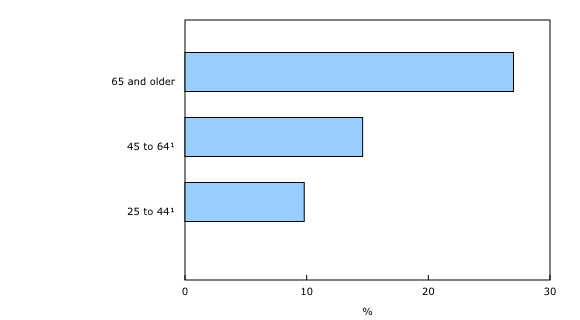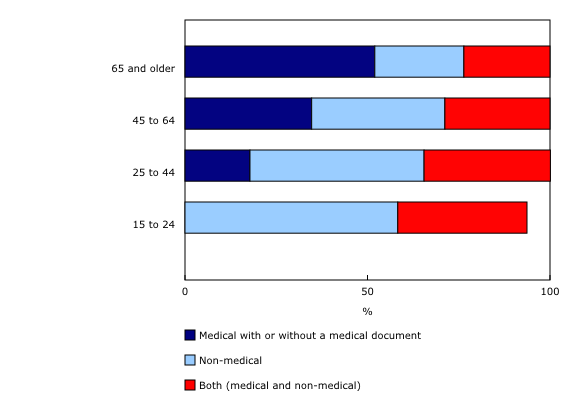National Cannabis Survey, third quarter 2019
Archived Content
Information identified as archived is provided for reference, research or recordkeeping purposes. It is not subject to the Government of Canada Web Standards and has not been altered or updated since it was archived. Please "contact us" to request a format other than those available.
Released: 2019-10-30
Canadians aged 65 and older are less likely to consume cannabis than younger Canadians; among those who do, they are more likely to have purchased their cannabis exclusively from a legal source and generally more likely to consume for medical reasons.
New data from the National Cannabis Survey (NCS) continue to show generational differences across various cannabis-related behaviours post legalization.
The Cannabis Act (C-45) became law on October 17, 2018. To monitor cannabis consumption before and after the legislative change, Statistics Canada has been conducting the NCS every three months since February 2018. This release provides the latest information about cannabis use in Canada. Analyses of combined data from the second and third quarters of 2019, as well as the third quarter 2019 update, are available.
Seniors are the age group showing the most growth in cannabis usage
Cannabis use is less common among seniors than it is in other age groups (7%, compared with 10% at ages 45 to 64, 25% at ages 25 to 44, and 26% at ages 15 to 24). However, cannabis consumption among seniors has been accelerating at a much faster pace than it has among other age groups. For example, in 2012, less than 1% of seniors (about 40,000) reported using, contrasting sharply with estimates from 2019 indicating that more than 400,000 seniors have used cannabis in the past three months.
The increasing popularity of cannabis among older adults has also contributed to an increase in the average age of cannabis users, which has risen from 29.4 years in 2004 to 38.1 in 2019.
More than one-quarter of seniors who use cannabis are new users
According to combined data collected during the second and third quarters of 2019, there are about 578,000 new cannabis users, that is, those who reported trying cannabis for the first time in the past three months. First-time use increases with age. While 10% of cannabis consumers aged 25 to 44 were new users in the second and third quarters of 2019, this was the case for more than one-quarter (27%) of cannabis consumers aged 65 and older.
Seniors less likely to use cannabis daily or almost daily
Using cannabis frequently can lead to a pattern of problematic use or use disorder. According to the most recent data from 2019, seniors were less likely to report daily or almost daily use compared with persons under the age of 65.
Seniors more likely to use cannabis for medical reasons
Canadians were asked to provide their main reason for using cannabis, that is, for non-medical use, for medical use (with or without a medical document), or for both medical and non-medical use.
Medical use was more common at older ages, while non-medical use predominated at younger ages. More than half (52%) of seniors aged 65 and older reported using cannabis exclusively for medical reasons, while the remaining seniors were evenly split between non-medical only (24%) and both medical and non-medical reasons (24%). In contrast, nearly 60% of youth aged 15 to 24 reported using cannabis exclusively for non-medical purposes and more than one-third (35%) reported consuming for both medical and non-medical reasons. Exclusive medical use among the youngest age group was rare, making the estimate too unreliable to be published.
Seniors the most likely to obtain cannabis exclusively from legal sources
An estimated 28% of cannabis users (1.4 million Canadians) reported obtaining all of the cannabis they consumed from a legal source, with consumers aged 65 and older (41%) being the most likely to be using only legally-obtained cannabis, compared with about one-quarter of younger consumers (23% to 29%, depending on age).
Many consumers obtain cannabis from multiple sources. If all of the people who reported getting at least some of their cannabis from a legal source are combined, the percentage of cannabis consumers accessing cannabis legally nearly doubles to 53% or 2.6 million Canadians.
Obtaining cannabis from other sources was also common and tended to differ across generations. For example, seniors were less likely (23%) to report having obtained cannabis from an illegal supplier, whereas youth aged 15 to 24 (52%) and adults aged 25 to 44 (43%) or 45 to 64 (39%) were more likely to do so. Seniors (30%) were also generally less likely than younger consumers (41% to 46%, depending on age) to have obtained cannabis from (or to have shared it with) friends and family.
Growing cannabis, either themselves or by someone else, was a supply source for about 8% of consumers, and about 4% reported another (unspecified) source—with no differences by age.
Where Canadians obtain their cannabis continues to change
More cannabis users reported obtaining cannabis from legal sources in the second and third quarters of 2019 (53%) compared with corresponding estimates from the same period in 2018 (23%), when non-medical cannabis was not yet legal. The percentages of consumers reporting only obtaining cannabis legally also rose, to 28% from 10% one year earlier. Examples of legal sources of cannabis include authorized retailers and online licensed producers. In contrast, fewer users reported obtaining cannabis from illegal sources such as a dealer in 2019 (42%) than in 2018 (52%), or from friends and family (39% in 2019 versus 49% in 2018).
Third quarter 2019: More than five million Canadians report having used cannabis
From mid-August to mid-September, nearly 5.2 million or 17% of Canadians aged 15 and older reported using cannabis in the previous three months. This was unchanged from one year earlier (before legalization).
Despite stability in the national rates, cannabis use did increase in the third quarter of 2019 compared with the third quarter of 2018, in some age groups and regions, including seniors and among persons aged 25 to 44 years of age.
In the third quarter of 2019, 24% of residents of Newfoundland and Labrador, 24% of residents of New Brunswick, 26% of residents of Prince Edward Island and 33% of Nova Scotians reported using cannabis. These proportions were above the average for the rest of Canada (other provinces combined), ranging from 8 to 11 percentage points higher than estimates from the previous year. Meanwhile, use in Quebec (11%) remained lower than the national average.
Note to readers
The Cannabis Act (C-45) became law on October 17, 2018. To prepare for this change, Statistics Canada adapted the national statistical system to measure the social and economic impacts of legalized cannabis.
Statistics Canada has been conducting the National Cannabis Survey (NCS) every three months since February 2018. The main objective of the NCS is to monitor changes in cannabis-related behaviours during the period preceding and following legalization of non-medical cannabis use by adults.
The NCS falls under the 'RapidStats' program being offered by the Centre for Social Data Integration and Development of Statistics Canada, to rapidly respond to pressing data needs.
The third quarter data (2018 or 2019) were collected in the 10 provinces in August and September of the corresponding year, while the second quarter surveys were collected in May and June.
The target population for the survey, regardless of quarter, is the household population aged 15 years and older, and excludes residents of institutions, the homeless and people living on Indigenous reserves.
The third quarter 2019 survey response rate was 50.9% and yielded a sample of 5,452. The corresponding figures for the third quarter 2018 survey were 51.6% (response rate) and 5,798 (sample). The second quarter 2019 survey's response rate was 46.9% and corresponded to a sample of 5,456 (excluding 1,010 respondents from the territorial capitals). The corresponding figures for the second quarter 2018 survey were 51.3% (response rate) and 6,068 (sample), excluding 1,217 respondents from the territorial capitals.
The survey features an Internet-based electronic questionnaire (EQ). The majority of respondents (61%) completed the survey unassisted using the secure access code sent by mail. Respondents who had not completed the survey by the third week of collection were contacted by telephone and asked to participate with the aid of a trained interviewer who read the questions and recorded the responses into the EQ application.
Cannabis includes marijuana, hashish, hash oil or any other preparation of the cannabis plant.
Data on current, former and no (never) cannabis use are based on responses to the following questions: "During the past three months, how often did you use cannabis?" and "Have you ever used or tried cannabis?" Current cannabis users were also classified according to how frequently they used cannabis in the three months before they were interviewed: once or twice, monthly, weekly, or daily or almost daily.
Persons reporting cannabis use were further separated into four groups based on responses to: "What is the main reason you use cannabis?" 1) non-medical, 2) medical use with a medical document, 3) medical use without a medical document, and 4) both medical use and non-medical use.
Data on the source of cannabis are based on responses to the following question: "In the past three months, where did you get the cannabis you used?" Eleven response categories were provided and reduced to five for this analysis: 1) Grow – I grow or someone else grows; 2) Legal – authorized retailer or online from a licensed producer; 3) Illegal – Compassion club, dispensary or storefront, online from another source, acquaintance, or dealer; 4) Friends or family – family member or friend or shared around a group of friends; 5) Other.
In an effort to better understand the purchasing behaviours of cannabis consumers and because consumers can access cannabis from multiple sources, persons who reported accessing cannabis from a legal source were further sub-divided to distinguish persons who accessed cannabis only from a legal source from those reporting more than one source.
Survey sampling weights were applied so that the analyses would be representative of the Canadian population.
For the combined second and third quarter analysis, the original sampling weights were adjusted by a factor of two (because there are two quarters) and limited to respondents of the 10 provinces only. By combining quarters, the analytical power of the survey is improved and the estimates reflect the average of the two quarters.
All differences between characteristics and the comparison groups discussed are statistically significant at the p < 0.05 level and were tested using t-test statistics and bootstrap replicate weights to account for the survey's complex sampling design.
Data limitations and cautions
The information in this release is self-reported and has not been validated. Social desirability and fear of punishment, both of which are potential sources of bias, may be especially relevant to this analysis. Changes over time in respondents' willingness to admit drug use may be influencing the statistics but remains difficult to measure.
Small sample sizes for some analyses may also have reduced the ability to reach statistical significance. Combining cycles and averaging results across quarters can improve statistical power and the stability of the estimates. As well, not all relevant covariates were available and it was sometimes necessary to use broader categories than would have been desirable.
Additional information
For more information regarding cannabis statistics, consult the Cannabis Stats Hub.
Statistics Canada is collecting information on cannabis prices through a crowdsourcing site, StatsCannabis. Please visit the site and share your information with confidence; participation is anonymous.
For other information on cannabis, see
Contact information
For more information, or to enquire about the concepts, methods or data quality of this release, contact us (toll-free 1-800-263-1136; 514-283-8300; STATCAN.infostats-infostats.STATCAN@canada.ca) or Media Relations (613-951-4636; STATCAN.mediahotline-ligneinfomedias.STATCAN@canada.ca).
- Date modified:





